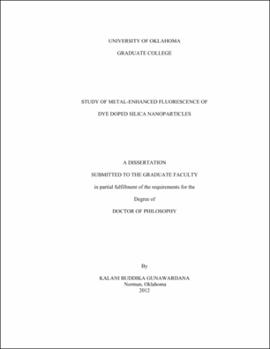| dc.contributor.advisor | Halterman, Ronald L | |
| dc.creator | Gunawardana, Gunawardana Buddika | |
| dc.date.accessioned | 2019-04-27T21:23:46Z | |
| dc.date.available | 2019-04-27T21:23:46Z | |
| dc.date.issued | 2012 | |
| dc.identifier | 99147157202042 | |
| dc.identifier.uri | https://hdl.handle.net/11244/318577 | |
| dc.description.abstract | Enhancement of molecular fluorescence is of great interest due to the widespread popularity of fluorescence-based detection techniques available today. Although fluorescence-based detection is considered to be more sensitive than other optical approaches, there is still an intense need for more photostable, high quantum yield fluorophores. In this regard, metal-enhanced fluorescence (MEF) has opened novel pathways for the development of brighter, fluorescent markers with enhanced stability. | |
| dc.description.abstract | Surface plasmon resonance of metal nanoparticles can modify the radiative properties of nearby fluorophores in ways not seen in classical fluorescence. Trapping fluorophores between coupled plasmons can further enhance the near-field interactions leading to even larger enhancements. The aim of this research was to a develop solution based approach to study MEF by aggregation of fluorophore tethered gold nanoparticles, which would ultimately lead to the development of ultra-bright fluorescent probes. | |
| dc.description.abstract | Thus, in the first part of the research we have studied place-exchange of different ligands on AuNP surface and photo-physical properties of dye capped gold nanoparticles. In this study we were able to develop a simple method to control the loading of dye (BODIPYdecylthioacetate) on gold nanoparticle surface using a competing ligand (11-mercaptoundecanoic acid). Furthermore, using this method we were able to calculate the molar fluorescence of adsorbed dye on gold nanoparticle surface. We have also developed several ligand exchange procedures which were beneficial to the second part of the research. | |
| dc.description.abstract | A goal of studying ligand exchange was to attach a fluorophore tethered third generation dendron to AuNP surface. This was crucial to get the desired spacing between the metal and the fluorophore which would give rise to MEF. During the course of the research we moved to a simpler approach to interact fluorophore doped silica nanoparticles with AuNPs. | |
| dc.description.abstract | In the second phase of our study we have used dye doped silica nanoparticles as fluorescent nano-platforms to bind with multiple AuNPs. Utilization of dye doped silica allowed us to have the desired spacing between the metal and the fluorophore to achieve MEF. Furthermore, ease of surface functionalization of silica allowed us to try various binding methods. Initially we tried electrostatic binding which did not yield MEF. In search of a more robust method, we functionalized the SiNP surface with dithiocarbamate which has a very high affinity to bind with gold. Using DTC chemistry we have developed a facile solution based method to aggregate dye doped silica nanoparticles with AuNPs which resulted remarkable fluorescence enhancements up to a 200-fold. We observed that fluorescence enhancement would increase with increased aggregation of AuNPs on dye doped SiNPs. | |
| dc.description.abstract | In the final phase we have investigated the dependence on MEF on the spectral overlap of the fluorophores with the plasmon resonance of AuNPs. We have used three different dyes for this investigation; Rhodamine B, Rubpy [tris(bipyridine) ruthenium(II) dichloride] and carboxy-BODIPY. Our results indicated that the spectral overlap of RhB results greatest enhancement with 13 nm AuNP aggregates. | |
| dc.description.abstract | We believe this simple solution based approach we have developed to produce bright photostable metal fluorophore aggregates would have a greater potential to be used in the development of ultra-bright fluorescent tags for cellular imaging. | |
| dc.format.extent | 167 pages | |
| dc.format.medium | application.pdf | |
| dc.language | en_US | |
| dc.relation.requires | Adobe Acrobat Reader | |
| dc.subject | Fluorescence | |
| dc.subject | Nanoparticles | |
| dc.title | Study of Metal-Enhanced Fluorescence of Dye-Doped Silica Nanoparticles | |
| dc.type | text | |
| dc.type | document | |
| dc.thesis.degree | Ph.D. | |
| ou.group | College of Arts and Sciences::Department of Chemistry and Biochemistry | |
